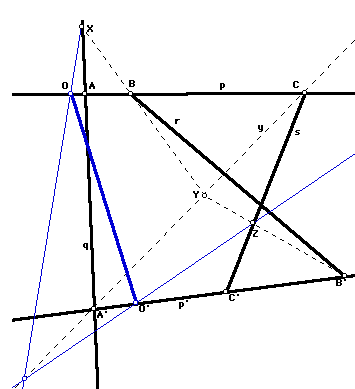The Construction of Line Conics
Say we are given five lines on a conic. In order to construct
more lines on this conic, we will need to construct a
projectivity between sets of three collinear points.

Let A, B, C be points on p, and A', B', C' points on p'.
Let Y be a point on the line Y=A'C.
Let X be the point AA'.BY.
Let Z be the point YB'.CC'.
Now, given any point O on p, use X to project it onto the
line y. Then use Z to project this new point onto the line p',
and call the result of this projection point O'. Our conic is
the locus of lines OO', as O becomes each point on the line p:

In order to construct our conic, we needed to construct a
projectivity that sent A=p.q to A'=p'.q, B=p.r to B'=p'.r,
and C=p.s to C'=p'.s.
Because there is only one such projectivity, any construction
giving those three correspondences will yield the same
projectivity. In particular, this shows that our conic did
not depend on our choice of point Y. Our choice of point did
affect the particulars of our construction, but it did not
affect the projectivity or the conic.
This construction, like all constructions in projective
geometry, requires a straightedge only.